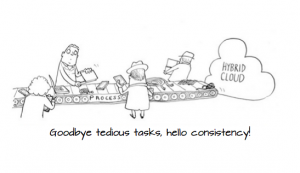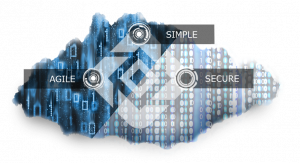You know that feeling you get when you find $40 in your pocket? You’re instantly thrilled and begin running through all the possibilities of what to do with it. Will you buy a new pair of shoes? Spend it on a night out with friends? Or maybe you will save it!
Now, take that same level of satisfaction and multiply it by one million. That’s how today’s IT leaders are feeling when they realize the benefits of implementing a hybrid cloud environment. According to the latest Principled Technologies study, an organization of approximately 30,000 employees with 5000 virtual machines can experience a potential $41.1 million in savings and benefits over a three-year period! Th is is one great indication why according to IDC more than 80% of enterprises will commit to hybrid cloud architectures by the end of 2017.
is is one great indication why according to IDC more than 80% of enterprises will commit to hybrid cloud architectures by the end of 2017.
Now you might be wondering, “that’s a huge number, how can I save that much?” The IT Service Transformation with Hybrid Cloud: Build vs Buy? study provides a deeper look into the cost and time savings a hybrid cloud can deliver. Of course each organization is different and therefore actual results may vary. Here’s what we learned:
Self-Service Portal and Catalog: Allowing IT consumers to request their own resources on-demand eliminates the time spent waiting for a request to be picked up from a queue and bypasses any review processes. Workers leveraging such catalogs were found to be between 2 to 4% more productive, which translates into real cost savings to the business. !
Automation and operational management: Workflows and service templates within the hybrid cloud ensure process standardization and automated execution, significantly reducing process complexity and making resources easier to access and consume. These efficiencies deliver huge benefits to cloud administrators, with up to a 56% time savings. When the tedious time consuming tasks have been done for you there is less time spent on manual, repetitive tasks and more time to spend on innovation!
Resiliency & Data Protection: IT departments are able to maintain visibility and control thanks to the self-service catalog. Access rights and security control policies are predefined so users can request IT and application resources as needed. The catalog provisions resources and workloads that are automatically aligned to pre-set cost, performance, and protection requirements leading to 6 fewer breaches and 36 less hours of downtime.
ITaaS & DevOps: Companies leveraging the self-service model are experiencing 15-30 days faster project delivery which can result in as much as a $5.9M revenue increase over 3 years. Developers can provision their development environments as platform as a service (PaaS) with the ability to easily define their service-level agreement (SLA) needs. At the end of the day, staff is devoting more time to delivering new business solutions and improving existing applications!
Enterprise wide resource pool: Last but not least, users can scale resource allocation up or down as needed and without the help of IT. Automated tools can help IT identify and eliminate capacity overprovisioning or underutilization. Think of this like a family cell phone plan. You can pinpoint who is wasting resources and find ways to cut down on costs. These are critical capabilities that can help you tame and better manage infrastructure growth resulting in potential savings up to $10.9M over 3 years!
BOTTOM LINE…
With savings and business value like these presented by Principle Technologies, it’s no wonder CIOs and CTOs alike are pushing for ITaaS technologies to help maintain their companies’ competitive edge. Considering only 20% of enterprises will not be committed to a hybrid cloud by 2017, traditional IT organizations run the risk of their market share slipping away right before their very eyes. Fast reacting, nimble competitors are prevalent. Not to mention they are moving quicker, more efficiently and with more money to spend on innovation!
The question now changes from “do we go down the hybrid cloud route?” to “how do we get there before our competitors?” Luckily we have an answer for that, too! For the full version of our whitepaper, get details here and stay tuned for Part 2 where we analyze the strategy and effectiveness of building your own hybrid cloud vs buying a fully engineered solution!
For more information on the Enterprise Hybrid Cloud, view our webpage or try an interactive demo.
